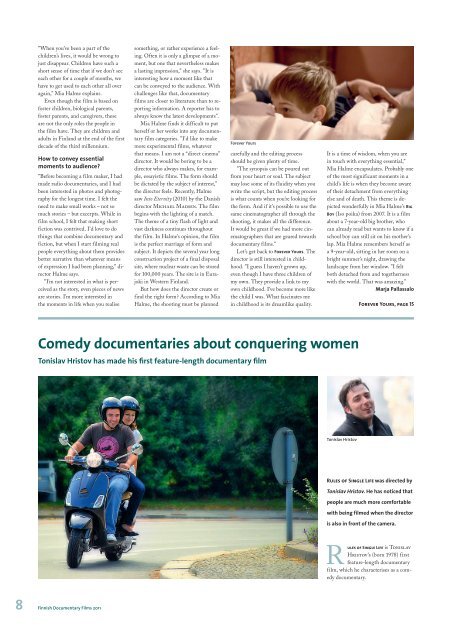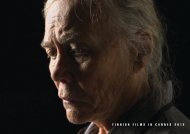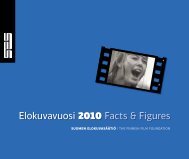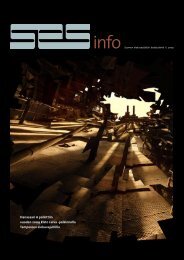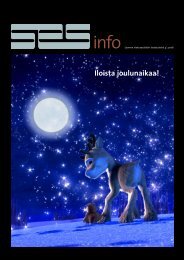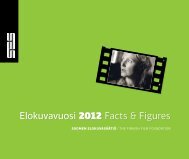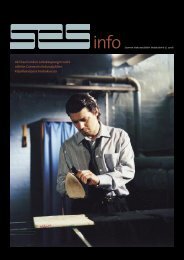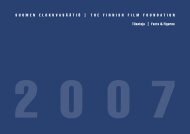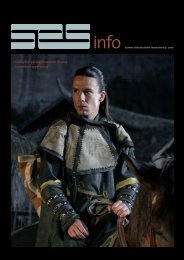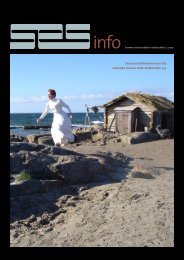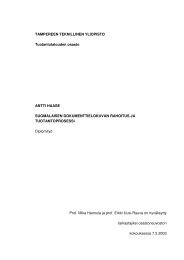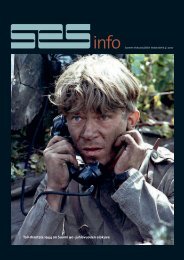Finnish Documentary Films 2011
Finnish Documentary Films 2011
Finnish Documentary Films 2011
Create successful ePaper yourself
Turn your PDF publications into a flip-book with our unique Google optimized e-Paper software.
”When you’ve been a part of the<br />
children’s lives, it would be wrong to<br />
just disappear. Children have such a<br />
short sense of time that if we don’t see<br />
each other for a couple of months, we<br />
have to get used to each other all over<br />
again,” Mia Halme explains.<br />
Even though the film is based on<br />
foster children, biological parents,<br />
foster parents, and caregivers, these<br />
are not the only roles the people in<br />
the film have. They are children and<br />
adults in Finland at the end of the first<br />
decade of the third millennium.<br />
How to convey essential<br />
moments to audience?<br />
”Before becoming a film maker, I had<br />
made radio documentaries, and I had<br />
been interested in photos and photography<br />
for the longest time. I felt the<br />
need to make small works – not so<br />
much stories – but excerpts. While in<br />
film school, I felt that making short<br />
fiction was contrived. I’d love to do<br />
things that combine documentary and<br />
fiction, but when I start filming real<br />
people everything about them provides<br />
better narrative than whatever means<br />
of expression I had been planning,” director<br />
Halme says.<br />
”I’m not interested in what is perceived<br />
as the story, even pieces of news<br />
are stories. I’m more interested in<br />
the moments in life when you realise<br />
something, or rather experience a feeling.<br />
Often it is only a glimpse of a moment,<br />
but one that nevertheless makes<br />
a lasting impression,” she says. ”It is<br />
interesting how a moment like that<br />
can be conveyed to the audience. With<br />
challenges like that, documentary<br />
films are closer to literature than to reporting<br />
information. A reporter has to<br />
always know the latest developments”.<br />
Mia Halme finds it difficult to put<br />
herself or her works into any documentary<br />
film categories. ”I’d like to make<br />
more experimental films, whatever<br />
that means. I am not a “direct cinema”<br />
director. It would be boring to be a<br />
director who always makes, for example,<br />
essayistic films. The form should<br />
be dictated by the subject of interest,”<br />
the director feels. Recently, Halme<br />
saw Into Eternity (2010) by the Danish<br />
director Michael Madsen. The film<br />
begins with the lighting of a match.<br />
The theme of a tiny flash of light and<br />
vast darkness continues throughout<br />
the film. In Halme’s opinion, the film<br />
is the perfect marriage of form and<br />
subject. It depicts the several year long<br />
construction project of a final disposal<br />
site, where nuclear waste can be stored<br />
for 100,000 years. The site is in Eurajoki<br />
in Western Finland.<br />
But how does the director create or<br />
find the right form? According to Mia<br />
Halme, the shooting must be planned<br />
Forever Yours<br />
carefully and the editing process<br />
should be given plenty of time.<br />
”The synopsis can be poured out<br />
from your heart or soul. The subject<br />
may lose some of its fluidity when you<br />
write the script, but the editing process<br />
is what counts when you’re looking for<br />
the form. And if it’s possible to use the<br />
same cinematographer all through the<br />
shooting, it makes all the difference.<br />
It would be great if we had more cinematographers<br />
that are geared towards<br />
documentary films.”<br />
Let’s get back to Forever Yours. The<br />
director is still interested in childhood.<br />
”I guess I haven’t grown up,<br />
even though I have three children of<br />
my own. They provide a link to my<br />
own childhood. I’ve become more like<br />
the child I was. What fascinates me<br />
in childhood is its dreamlike quality.<br />
It is a time of wisdom, when you are<br />
in touch with everything essential,”<br />
Mia Halme encapsulates. Probably one<br />
of the most significant moments in a<br />
child’s life is when they become aware<br />
of their detachment from everything<br />
else and of death. This theme is depicted<br />
wonderfully in Mia Halme’s Big<br />
Boy (Iso poika) from 2007. It is a film<br />
about a 7-year-old big brother, who<br />
can already read but wants to know if a<br />
school boy can still sit on his mother’s<br />
lap. Mia Halme remembers herself as<br />
a 9-year-old, sitting in her room on a<br />
bright summer’s night, drawing the<br />
landscape from her window. ”I felt<br />
both detached from and togetherness<br />
with the world. That was amazing.”<br />
Marja Pallassalo<br />
Forever Yours, page 15<br />
Comedy documentaries about conquering women<br />
Tonislav Hristov has made his first feature-length documentary film<br />
Tonislav Hristov<br />
Rules of Single Life was directed by<br />
Tonislav Hristov. He has noticed that<br />
people are much more comfortable<br />
with being filmed when the director<br />
is also in front of the camera.<br />
Rules<br />
R<br />
of Single Life is Tonislav<br />
Hristov’s (born 1978) first<br />
feature-length documentary<br />
film, which he characterises as a comedy<br />
documentary.<br />
8 <strong>Finnish</strong> <strong>Documentary</strong> <strong>Films</strong> <strong>2011</strong>


